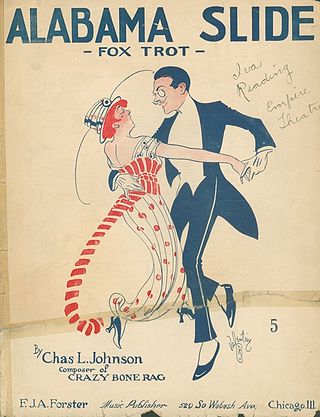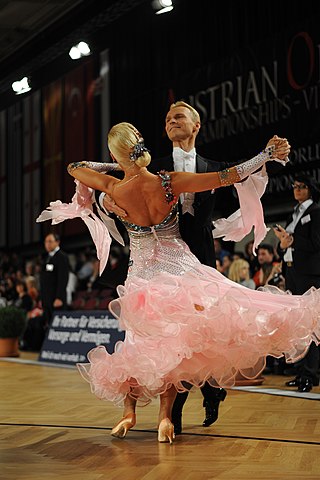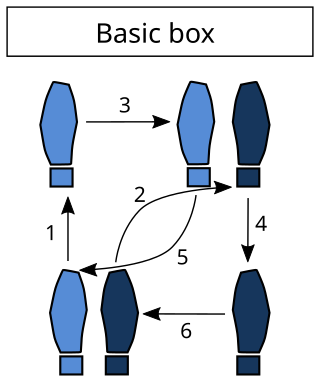Related Research Articles

Ballroom dance is a set of European partner dances, which are enjoyed both socially and competitively around the world, mostly because of its performance and entertainment aspects. Ballroom dancing is also widely enjoyed on stage, film, and television.

Viennese waltz is a genre of ballroom dance. At least four different meanings are recognized. In the historically first sense, the name may refer to several versions of the waltz, including the earliest waltzes done in ballroom dancing, danced to the music of Viennese waltz.

The foxtrot is a smooth, progressive dance characterized by long, continuous flowing movements across the dance floor. It is danced to big band music. The dance is similar in its look to waltz, although the rhythm is in a 4
4 time signature instead of 3
4. Developed in the 1910s, the foxtrot reached its height of popularity in the 1930s and remains practiced today.

Modern social round dance, or round dancing, is a choreographed and cued ballroom dance that progresses in a circular counter-clockwise pattern around the dance floor. The two major categories of ballroom dances found in round dancing are the smooth and international ballroom styles and the Latin dances. It is not to be confused with circle dancing, which is a type of folk dance in which dancers are connected in a circular chain.
This is a list of dance terms that are not names of dances or types of dances. See List of dances and List of dance style categories for those.

In ballroom dancing, directions of progressive movement, in particular directions of steps, can be indicated either in relation to the room or in relation to the body position. Directions of turns, although there are only two of them, may also be indicated in several ways.

The quickstep is a light-hearted dance of the standard ballroom dances. The movement of the dance is fast and powerfully flowing and sprinkled with syncopations. The upbeat melodies that quickstep is danced to make it suitable for both formal and informal events. Its origins are in combination of slow foxtrot combined with the Charleston, a dance which was one of the precursors to what today is called swing dancing.
In many forms of dance medal examinations are held. They are organised by leading dance teaching organisations, such as the Imperial Society of Teachers of Dancing (ISTD), the International Dance Teachers Association (IDTA), and other organisations.

Box step is a basic dance step named after the pattern it creates on the floor, which is that of a square or box. It is used in a number of American Style ballroom dances: rumba, waltz, bronze-level foxtrot. While it can be performed individually, it is usually done with a partner. This is the most common dance step in the waltz. In international standard dance competition, there is a similar step called closed change.
The closed change is a Pre-Bronze, or newcomer waltz figure, performed in closed position. Changes may start of the right foot or left foot, moving forward or backward. This makes four different types of closed changes. Combining two changes results in a box step. In right changes the man starts from the right foot, while in left ones the man starts from the left foot.
The feather or feather step is a dance figure in the International Style foxtrot. Depending on a syllabus, it consists of three or four steps, with the third step done outside the lady with a slight turn in the body position to the right.

Waltz is one of the five dances in the Standard category of the International Style ballroom dances. It was previously referred to as slow waltz or English waltz.
The counter promenade position is a dance position in ballroom and other dances. It is described differently in various dance categories, but essentially it is the opposite of the promenade position.

A fleckerl is a dance step, most commonly found in the Viennese waltz. Unlike the natural and reverse turns, the fleckerl does not move forwards along the dance floor but instead rotates on the spot.
British Ice Skating is the national governing body of ice skating within the United Kingdom. Formed in 1879, it is responsible for overseeing all disciplines of ice skating: figure skating ; synchronised skating; and speed skating.
The whisk is a ballroom dance step used in the waltz and American style Viennese waltz. It is one of several ways to get into promenade position and is used to turn dancers around corners or change their direction on the dance floor. It can be performed after a reverse turn.
The Telemark is a ballroom dance step; in waltz competition, it is in the Silver syllabus. Telemarks are reverse turns where the follower does a heel turn as the leader travels around her. There are similar Telemarks in foxtrot and quickstep.
A wing is a ballroom dance move, in the silver syllabus of competition waltz. It is a transitional movement that repositions the follower to the leader's left side. Thus, while many dance moves can precede a wing, only a reverse movement can follow a wing, such as a reverse turn, double reverse spin, Telemark, fallaway reverse, or drag hesitation.
There are several types of lock step in waltz dancing, including International Standard waltz. A "lock step" is when the moving foot approaches to the standing foot and crosses in front of or behind it, creating a "check" position.
References
- 1 2 "Reverse turn". BallroomDancers.com. Retrieved 2020-05-02.
- ↑ International Dance Syllabus
- ↑ "What Is Natural About A Natural Turn?". Round Dancing. Retrieved 2020-04-30.
- ↑ "How to do a Dance Turn: Reverse and Natural Turns". SocialBallroom.dance. Retrieved 2020-04-30.
- ↑ "Natural turn". BallroomDancers.com. Retrieved 2020-05-02.